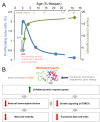Folding mutations suppress early beta-cell proliferation
- PMID: 30547883
- PMCID: PMC6294546
- DOI: 10.7554/eLife.43475
Folding mutations suppress early beta-cell proliferation
Abstract
Exploring how proliferation and maturation of beta-cells can be impaired after birth will shed light on the origins of various forms of diabetes.
Keywords: beta-cell maturation; beta-cell proliferation; diabetes; endoplasmic reticulum stress; human; human biology; insulin gene mutations; mTORC1; medicine; mouse; regenerative medicine; stem cells.
© 2018, Modi and Johnson.
Conflict of interest statement
HM, JJ No competing interests declared
Figures

Comment on
-
Inhibition of mTORC1 by ER stress impairs neonatal β-cell expansion and predisposes to diabetes in the Akita mouse.Elife. 2018 Nov 9;7:e38472. doi: 10.7554/eLife.38472. Elife. 2018. PMID: 30412050 Free PMC article.
-
Insulin mutations impair beta-cell development in a patient-derived iPSC model of neonatal diabetes.Elife. 2018 Nov 9;7:e38519. doi: 10.7554/eLife.38519. Elife. 2018. PMID: 30412052 Free PMC article.
References
-
- Balboa D, Saarimäki-Vire J, Borshagovski D, Survila M, Lindholm P, Galli E, Eurola S, Ustinov J, Grym H, Huopio H, Partanen J, Wartiovaara K, Otonkoski T. Insulin mutations impair beta-cell development in a patient-derived iPSC model of neonatal diabetes. eLife. 2018;7:e38519. doi: 10.7554/eLife.38519. - DOI - PMC - PubMed
Publication types
MeSH terms
Substances
Grants and funding
LinkOut - more resources
Full Text Sources
Medical

